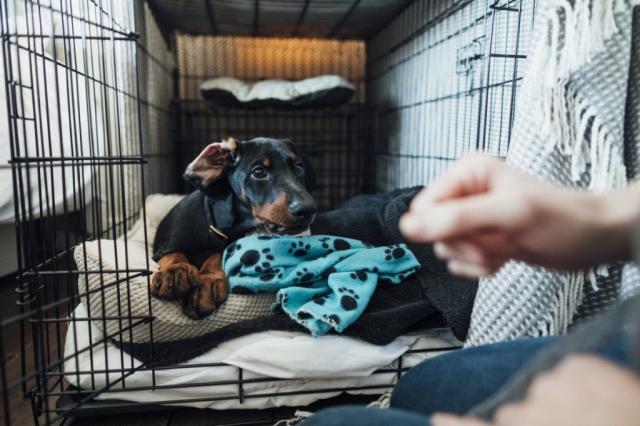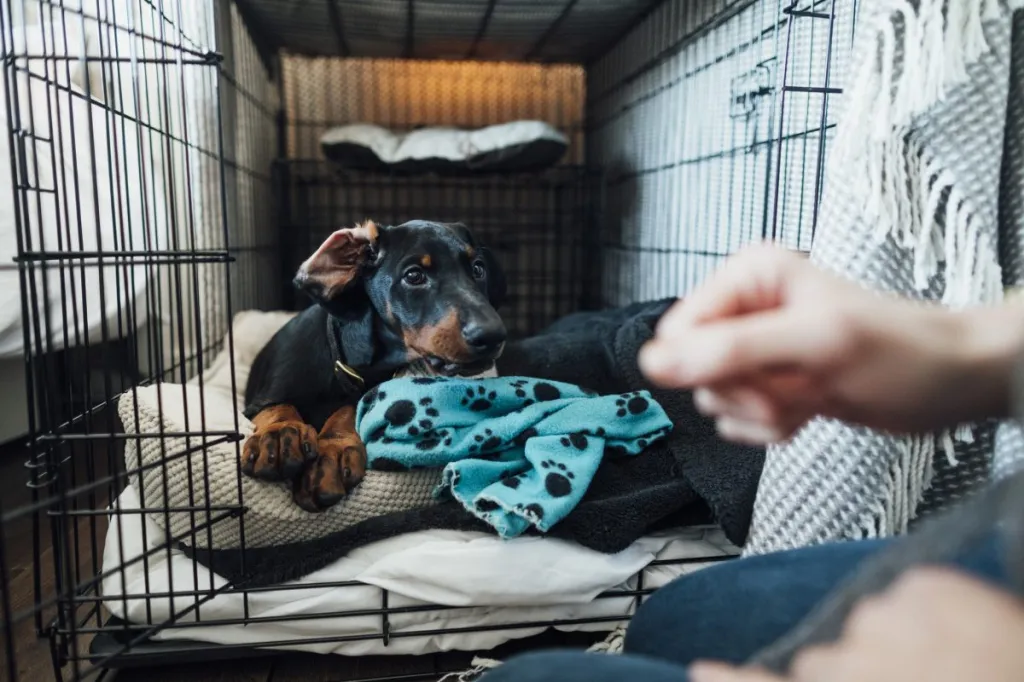Crate training your dog is an essential aspect of pet parenting that can provide numerous benefits such as promoting safety, reducing destructive behaviors, and aiding in housetraining. By creating a designated safe space for your dog, you can help them feel secure and provide them with a place to relax and unwind.
Additionally, crate training can also assist with separation anxiety and help teach your dog how to settle down and entertain themselves when you’re not around. It’s important to approach crate training with patience and consistency, ensuring that the crate is associated with positive experiences.

Credit: dogtime.com
Why Crate Training Is Important
When it comes to properly training your dog, crate training is a crucial step that every pet parent should consider. Crate training provides a safe and secure space for your dog, helps with potty training, and reduces destructive behaviors. Let’s explore each of these benefits in detail:
Safe Space For The Dog
A crate serves as a safe and comfortable haven for your furry friend. Dogs are den animals by nature, and a crate mimics the feeling of a den, providing them with a sense of security and privacy. Having a designated safe space can help alleviate anxiety and stress, especially during noisy or hectic situations. It also gives them a place to retreat to when they need rest and relaxation.
Helps With Potty Training
Crate training is highly effective for successfully potty training your dog. Dogs naturally avoid soiling their living area, and by confining them to a crate when you can’t supervise them, you are helping them develop bladder and bowel control. Remember to take them outside to their designated potty spot as soon as you let them out of the crate, reinforcing the habit of eliminating in the appropriate area.
Reduces Destructive Behaviors
Destructive behaviors, such as chewing on furniture, shoes, or household items, are common in dogs, particularly when they are bored or anxious. Crate training can play a pivotal role in reducing these destructive behaviors. By providing a confined and secure space, you can eliminate the temptation for your dog to chew on forbidden items. It also prevents them from engaging in dangerous activities when you are not around to supervise them, keeping both your pet and your belongings safe.
In conclusion, crate training is an essential aspect of responsible pet parenting. It offers numerous benefits, including creating a safe space for your dog, aiding in potty training, and reducing destructive behaviors. By properly introducing your furry friend to crate training in a positive and gentle manner, you can help them become a well-adjusted and happy member of your family.

Credit: m.facebook.com
Common Concerns About Crate Training
Crate training your dog can be a source of concern for pet parents, but it offers benefits such as providing a safe space for your dog, aiding in potty training, and managing behavior. Not crate training your dog may lead to issues with potty training and separation anxiety.
Crating Syndrome And Its Consequences
Crating syndrome refers to the negative impact that prolonged crate confinement can have on a dog. Many crated dogs experience severe depression, withdrawal, and even develop separation anxiety or Stockholm syndrome. The use of crates can also lead to hyperactivity and behavioral issues in dogs. It’s essential for pet parents to understand the consequences of crating and make informed decisions about their dog’s well-being.
Separation Anxiety
Separation anxiety is a common concern when it comes to crate training. Dogs are social animals and can feel anxious or stressed when left alone for extended periods, even in a secure crate. It’s crucial for pet parents to gradually introduce crate time and ensure that their furry companions feel comfortable and safe. Providing engaging toys, treats, and positive reinforcement during crate training can help alleviate separation anxiety.
Escape During Emergencies
During emergencies, it is essential for dogs to have a way to escape and seek safety. However, crated dogs may face challenges when it comes to escaping from their crates. This can put them at risk during situations such as fire outbreaks or natural disasters when no one else is at home. Pet parents must carefully consider escape routes and ensure that their dogs have access to safe areas in case of emergencies.
Overall, crate training can be beneficial for both dogs and their owners. It provides a designated safe space for dogs, aids in potty training, and helps manage behavior. However, pet parents must be aware of common concerns such as crating syndrome, separation anxiety, and the need for escape during emergencies. By addressing these concerns and implementing proper training techniques, pet parents can create a positive environment for their beloved furry friends.
Benefits Of Crate Training
Crate training your dog has numerous benefits, including keeping them safe, reducing destructive behavior, and aiding in housetraining. It provides them with a designated safe space and helps manage their behavior, making it a valuable practice for pet parents to consider.
n a series of small steps.Safety When Owner Is Away
Crate training provides a safe environment for your dog when you are away from home, ensuring their safety and preventing them from engaging in potentially dangerous behaviors. By confining your dog to a crate, you can rest assured knowing that they are secure and protected from household hazards, such as electrical cords, toxic substances, or objects that can be swallowed. Additionally, crates can prevent your dog from escaping or wandering off, reducing the risk of accidents or injuries outside the home.Reduces Destructive Behaviors
Crate training plays a crucial role in curbing destructive behaviors that may arise when your dog is left alone. Dogs naturally crave structure and boundaries, and being confined to a crate simulates the den-like environment they would seek in the wild. This confinement helps prevent them from engaging in destructive behaviors, such as chewing furniture, digging holes, or raiding the trash. By providing a safe and controlled space, crate training helps your dog develop a sense of security, reducing anxiety and curbing unwanted behaviors.Aids In Housetraining
Crate training is an invaluable tool for housetraining your dog. Dogs naturally avoid soiling their sleeping area, and by confining them to a crate, you can encourage them to hold their bladder and bowels until they are let outside. This creates a consistent routine and teaches your dog to associate elimination with outdoor spaces. As a result, your dog becomes more aware of their bodily functions and learns to communicate their needs, making the process of housetraining more efficient and effective. Using a crate for housetraining also helps you monitor your dog’s behavior closely, allowing you to identify signs that they need to go outside. Additionally, it prevents your dog from having accidents around the house, making the cleanup process easier and maintaining a cleaner living environment for both you and your furry friend. In conclusion, crate training offers numerous benefits for both you and your dog. It provides a safe and secure space for your dog when you are away, reduces destructive behaviors, and aids in the housetraining process. Embracing crate training as part of your dog’s training regimen can lead to a happier, healthier, and well-behaved companion. So, start crate training today and enjoy the peace of mind that comes with knowing your dog is safe, comfortable, and well-adjusted.How To Crate Train Your Dog
Crate training your dog is an essential step for pet parents, as it provides a safe space for your dog and assists with potty training and behavior management. By following a series of small steps and associating the crate with positive experiences, you can create a comfortable and secure environment for your dog.
Introducing The Crate Slowly
Crate training your dog can be a valuable tool in maintaining their safety and well-being. To ensure a positive experience, it’s crucial to introduce the crate slowly and gradually. Begin by placing the crate in a familiar and comfortable space, such as the living room or bedroom. Make the crate inviting by adding their favorite blanket or toy inside. Allow your pooch to explore the crate at their own pace, ensuring they associate it with positive experiences. Never force your dog into the crate, as this can create negative associations.
Games And Mental Stimulation In And Around The Crate
Make crate time an enjoyable experience for your furry friend by incorporating games and mental stimulation. Use treats and toys to encourage your dog to enter the crate willingly. Once inside, engage them in interactive games, such as hide-and-seek with treats or puzzle toys. These activities will not only keep your dog occupied but also strengthen the positive association with the crate. Additionally, try placing food puzzles or chew toys outside the crate to encourage them to explore the area around it, fostering a sense of comfort and security.
Avoiding Common Mistakes
As you embark on crate training your dog, it’s essential to avoid common mistakes that can hinder their progress. Firstly, never use the crate as a form of punishment. This can create fear and anxiety surrounding the crate, making it counterproductive. Additionally, avoid keeping your dog confined for extended periods without breaks. They should have frequent opportunities for exercise, play, and bathroom breaks to prevent discomfort and accidents. Lastly, refrain from using the crate as a long-term solution for separation anxiety or behavioral issues. Seek professional guidance to address the root cause of these problems.
Gradual Progression In Crate Time
Gradual progression is key to successfully crate training your dog. Start by leaving your dog in the crate for short periods, gradually increasing the duration as they become more comfortable. Begin with just a few minutes and slowly extend it to half an hour, an hour, and eventually a few hours at a time. Ensure you provide plenty of positive reinforcement and rewards when your dog stays calm and relaxed in the crate. This will help them associate the crate with positive experiences and build their confidence.
In conclusion, crate training your dog can provide numerous benefits, such as ensuring their safety, aiding in potty training, and creating a designated safe space. By introducing the crate slowly, incorporating games and mental stimulation, avoiding common mistakes, and gradually increasing crate time, you can effectively crate train your dog and promote their overall well-being.
Successful Crate Training Tips
Crate training is an essential part of raising a well-behaved and happy dog. It provides them with their own safe space and helps with potty training and behavior management. To ensure successful crate training, here are some tips to keep in mind:
Practicing Having The Crate Door Shut
One of the crucial steps in crate training is getting your dog comfortable with the crate door being shut. This helps them feel secure and calm when inside. To accomplish this, start by gradually increasing the amount of time your dog spends in the crate with the door closed. Begin with just a few minutes and gradually build up to longer periods. Pair this with positive reinforcement, giving them treats and praise when they remain calm. Remember to never force your dog into the crate or use it as a form of punishment, as this can create negative associations.
Favorite Tools For Crate Training
There are several tools that can assist in crate training your dog, making the process smoother and more effective. Here are some of our top recommendations:
| Tools | Description |
|---|---|
| Comfortable bedding | Provide your dog with a soft and cozy bed to make the crate inviting and comfortable. |
| Interactive toys | Keep your dog entertained and engaged while in the crate by providing them with interactive toys and puzzle feeders. |
| Treat-dispensing toys | Use treat-dispensing toys to reward your dog for good behavior and keep them occupied during crate time. |
| Crate cover | A crate cover can create a den-like environment, making your dog feel safe and secure. |
By utilizing these tools, you can make the crate a positive and enjoyable space for your dog, enhancing their training experience.
Remember, crate training takes time and patience. Each dog is unique, so the duration of the training process may vary. Stay consistent, be positive, and provide plenty of praise and rewards along the way. With these successful crate training tips, you’ll be well on your way to having a well-adjusted and happy canine companion.

Credit: www.yahoo.com
Frequently Asked Questions On Crate Training Your Dog: Everything Pet Parents Should Know
At What Age Should I Stop Putting My Dog In A Crate?
You can usually stop putting your dog in a crate around two years of age. Before then, they are more likely to get into trouble. Crate training can provide a safe space for your dog and help with potty training and behavior management.
What Is Crate Syndrome?
Crate syndrome is a condition that affects dogs who are crated for extended periods. It can lead to severe depression, withdrawal, separation anxiety, and behavioral issues. Crating can also pose risks in case of emergencies. Crate training is recommended for dogs as it provides a safe space, aids in potty training, and helps manage behavior.
Is It Ok To Not Crate Train Your Dog?
Crate training your dog is beneficial for both you and your dog. It provides a safe space, helps with potty training and behavior management. Without crate training, your dog may struggle with potty training and separation anxiety.
Is It Normal To Feel Overwhelmed When You Get A Puppy?
Feeling overwhelmed when getting a puppy is normal. New owners may worry about their puppy’s health and whether they’re doing everything right. It’s natural to feel out of your comfort zone.
Conclusion
Crate training is an essential practice for pet parents to ensure the well-being of their dogs. It provides a safe space, aids in potty training, manages behavior, and reduces destructive habits. The training process may vary in duration, but it is crucial to associate the crate with positive experiences and progress gradually.
By crate training your dog, you are promoting their safety, comfort, and overall happiness.







